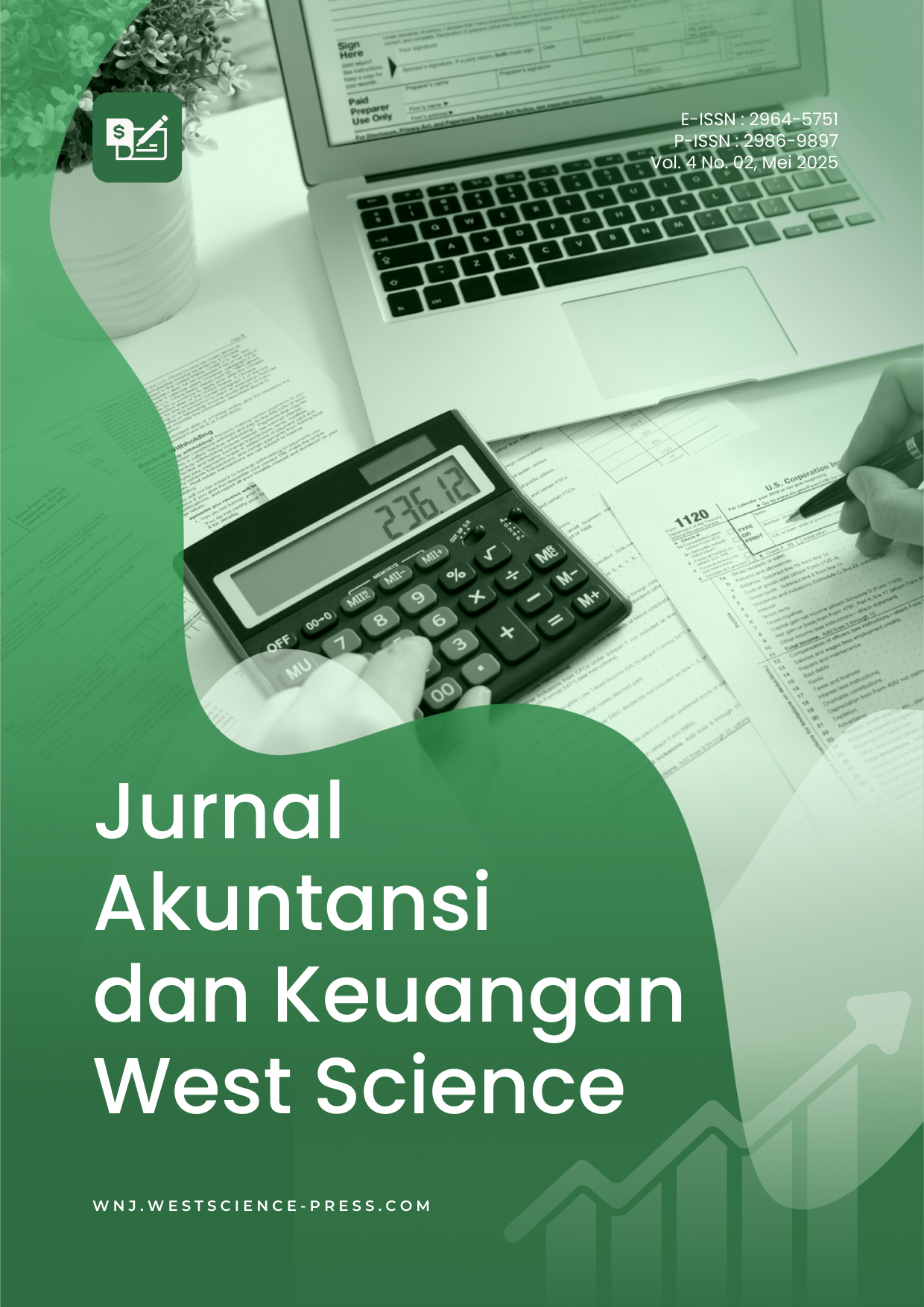Analisis Bibliometrik atas Literatur Green Finance
DOI:
https://doi.org/10.58812/jakws.v4i02.2183Kata Kunci:
Green Finance, Bibliometrik, ESG Fintech, Keberlanjutan, VOSviewerAbstrak
Penelitian ini bertujuan untuk memetakan perkembangan dan struktur konseptual literatur mengenai green finance melalui pendekatan bibliometrik. Data diperoleh dari basis data Scopus untuk periode 2010–2024 dan dianalisis menggunakan perangkat lunak VOSviewer. Analisis dilakukan terhadap 3 aspek utama: kolaborasi penulis (co-authorship), jejaring negara, dan kemunculan bersama kata kunci (co-word analysis), termasuk visualisasi overlay dan density untuk melihat dinamika tematik dari waktu ke waktu. Hasilnya menunjukkan bahwa China merupakan negara paling dominan dalam produksi dan kolaborasi penelitian green finance, dengan kontribusi signifikan dari penulis-penulis Asia lainnya. Topik inti yang paling sering dibahas meliputi green economy, economic development, climate change, dan renewable energy. Dalam dua tahun terakhir, terjadi pergeseran fokus penelitian ke arah topik-topik seperti ESG, fintech, dan inovasi keuangan berkelanjutan. Visualisasi density menunjukkan kepadatan tinggi pada konsep-konsep utama, namun juga mengungkap adanya celah riset pada tema urbanisasi, efisiensi keuangan, dan transformasi digital hijau. Studi ini memberikan kontribusi penting dalam membangun peta keilmuan green finance sekaligus merekomendasikan arah riset lanjutan yang lebih inklusif dan multidisipliner.
Referensi
[1] C.-H. Yu, X. Wu, D. Zhang, S. Chen, and J. Zhao, “Demand for green finance: Resolving financing constraints on green innovation in China,” Energy Policy, vol. 153, p. 112255, 2021.
[2] N. Liu, C. Liu, Y. Xia, Y. Ren, and J. Liang, “Examining the coordination between green finance and green economy aiming for sustainable development: A case study of China,” Sustainability, vol. 12, no. 9, p. 3717, 2020.
[3] J. He, W. Iqbal, and F. Su, “Nexus between renewable energy investment, green finance, and sustainable development: Role of industrial structure and technical innovations,” Renew. Energy, vol. 210, pp. 715–724, 2023.
[4] I. Hatak, R. Harms, and M. Fink, “Age, job identification, and entrepreneurial intention,” J. Manag. Psychol., vol. 30, no. 1, pp. 38–53, 2015.
[5] S. Spinaci, “Green and sustainable finance,” 2021.
[6] Z. A. Paray and S. Kumar, “Does entrepreneurship education influence entrepreneurial intention among students in HEI’s? The role of age, gender and degree background,” J. Int. Educ. Bus., vol. 13, no. 1, pp. 55–72, 2020.
[7] N. Donthu, S. Kumar, D. Mukherjee, N. Pandey, and W. M. Lim, “How to conduct a bibliometric analysis: An overview and guidelines,” J. Bus. Res., vol. 133, pp. 285–296, 2021.
[8] R. Passaro, I. Quinto, and A. Thomas, “The impact of higher education on entrepreneurial intention and human capital,” J. Intellect. Cap., vol. 19, no. 1, pp. 135–156, 2018.
[9] C.-C. Lee and C.-C. Lee, “How does green finance affect green total factor productivity? Evidence from China,” Energy Econ., vol. 107, p. 105863, 2022.
[10] D. Zhang, M. Mohsin, A. K. Rasheed, Y. Chang, and F. Taghizadeh-Hesary, “Public spending and green economic growth in BRI region: mediating role of green finance,” Energy Policy, vol. 153, p. 112256, 2021.
[11] F. Taghizadeh-Hesary and N. Yoshino, “The way to induce private participation in green finance and investment,” Financ. Res. Lett., vol. 31, pp. 98–103, 2019.
[12] M. Irfan, A. Razzaq, A. Sharif, and X. Yang, “Influence mechanism between green finance and green innovation: exploring regional policy intervention effects in China,” Technol. Forecast. Soc. Change, vol. 182, p. 121882, 2022.
[13] X. Zhou, X. Tang, and R. Zhang, “Impact of green finance on economic development and environmental quality: a study based on provincial panel data from China,” Environ. Sci. Pollut. Res., vol. 27, pp. 19915–19932, 2020.
[14] D. Zhang, Z. Zhang, and S. Managi, “A bibliometric analysis on green finance: Current status, development, and future directions,” Financ. Res. Lett., vol. 29, pp. 425–430, 2019.
[15] S. Zhang, Z. Wu, Y. Wang, and Y. Hao, “Fostering green development with green finance: An empirical study on the environmental effect of green credit policy in China,” J. Environ. Manage., vol. 296, p. 113159, 2021.
[16] Y. Wang and Q. Zhi, “The role of green finance in environmental protection: Two aspects of market mechanism and policies,” Energy Procedia, vol. 104, pp. 311–316, 2016.
[17] E. Rasoulinezhad and F. Taghizadeh-Hesary, “Role of green finance in improving energy efficiency and renewable energy development,” Energy Effic., vol. 15, no. 2, p. 14, 2022.
Unduhan
Dimensions
Diterbitkan
Terbitan
Bagian
Lisensi
Hak Cipta (c) 2025 Loso Judijanto

Artikel ini berlisensiCreative Commons Attribution-ShareAlike 4.0 International License.






















 Instagram
Instagram 